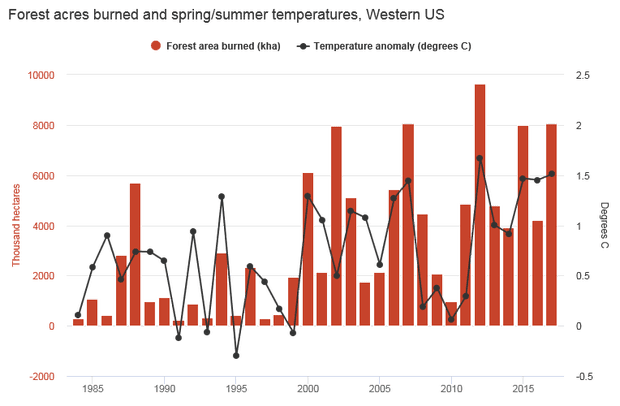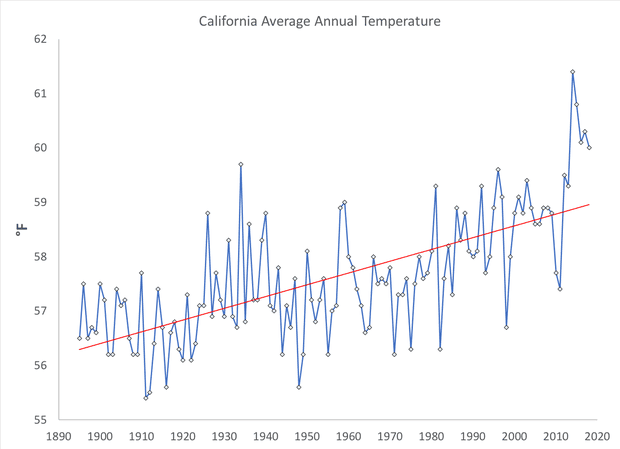California wildfires are being magnified & made so much worse by the bad environmental laws which aren’t allowing massive amounts of readily available water to be properly utilized. It is being diverted into the Pacific Ocean. Must also tree clear to stop fire from spreading!
Trump reignited his war with California, but his Tweet got burned
Posted on 13 August 2018 by dana1981
Last week, 18 wildfires were burning at once in California, including its largest in history, destroying over 1,100 homes and forcing tens of thousands of residents to evacuate. The smoke made the air in the state’s Central Valley unhealthy to breathe for a record 15 consecutive days, as I can personally attest.
Donald Trump decided to use the opportunity to renew his war with California by nonsensically blaming the wildfires on environmental laws.
It’s no surprise that Donald Trump dislikes California. His 2.9m national popular vote deficit to Hillary Clinton is a sore spot, and her margin of victory in California was by 30% and 4.3m votes. California has also long been a leader in developing laws to clean and protect the environment, and Trump despises regulations that benefit public health and welfare at the expense of industry profits.
And so, we got the Tweet bemoaning water being “diverted into the Pacific Ocean” (in scientific terms, they’re called “rivers”). Daniel Berlant, assistant deputy director of Cal Fire immediately noted that water isn’t firefighters’ problem:
We have plenty of water to fight these wildfires, but let’s be clear: It’s our changing climate that is leading to more severe and destructive fires
Climate change is making wildfires bigger
Although Rep. Doug LaMalfa (R-CA), who represents the district encompassing Redding (or what’s left of it) denied the reality of human-caused climate change in an interview with the Guardian, the scientific research clearly shows that global warming is exacerbating wildfires. As one might expect, hotter, drier conditions lead to bigger fires. Zeke Hausfather showed in an analysis for Carbon Brief that there’s a strong correlation between temperatures and the total area of forests burned in the western USA.

Red bars show western US forest area burned (in thousand hectares) using data provided by Prof John Abatzoglou, updated from the data used in Abatzoglou and Williams (2016). Black line shows March-August temperature anomalies relative to a 1961-1990 baseline period for the US west of 102 degrees longitude using data from NOAA. Illustration: Zeke Hausfather, Carbon Brief
A 2016 study in the Proceedings of the National Academy of Sciences found that 75% of year-to-year variations in area burned by wildfires in the western US can be explained by fuel aridity (a combination of temperature and precipitation), and:
Anthropogenic climate change accounted for ∼55% of observed increases in fuel aridity from 1979 to 2015 across western US forests … and doubled the cumulative forest fire area since 1984
July 2018 was the hottest month ever recorded in California. The past four years were the state’s four hottest, and 2018 is on pace to also finish in California’s top-five hottest years. Plus, California just recently emerged from its worst drought in over a millennium, which was likewise amplified by global warming and created plentiful wildfire fuel.

California average annual temperature data from Noaa (blue) and linear trend (red). Illustration: Dana Nuccitelli
Other factors like forest management have also played a role in the growing size of wildfires, but human-caused climate change is clearly a major contributor. Under a high-emissions global warming scenario, a 2011 studyfound that by the end of the century the annual area burned by wildfires in California would increase by about 50%, and would double in heavily-forested Northern California.
It’s also worth noting that forest management is primarily a federal, not state issue, headed by the Department of Interior and US Forest Service. As the Sacramento Bee reported:
The Trump administration’s own budget request for the current fiscal year and the coming one proposed slashing tens of millions of dollars from the Department of Interior and U.S. Forest Service budgets dedicated to the kind of tree clearing and other forest management work experts say is needed.
Ironically, California has been using the $256m allocated to wildfire risks from the state’s carbon cap and trade system revenues. Visiting the state yesterday, Trump’s Interior Secretary Ryan Zinke said:
It doesn’t matter whether you believe or don’t believe in climate change. What is important is we manage our forests.
But given that global warming doubled the area burned by forest fires over the past three decades, it really does matter that the Trump administration denies climate change and is actively making the problem worse.
California is fighting climate change. Trump is fighting California
Meanwhile, California and the Trump EPA are battling over vehicle fuel efficiency standards, which had not improved for decades until the Obama administration took office and bailed out the American auto industry, whose gas guzzlers became unpopular when gasoline prices spiked.































 Arguments
Arguments






























Alex Jones' term 'InfoWars' describes what Trump is doing here. In War, truth is the first casualty. Once the fossil-fueled rightwing disinformation network has convinced voters in critical states that 'there's a war on for your mind' (as Jones puts it), then all information becomes a weapon and either acts to defeat the enemy or weakens 'our side'. Trump is lying, knows he's lying, his troops know he's lying, and the 'enemy' knows he's lying. It doesn't matter, the information either hurts the other side or it doesn't, and if it doesn't, then it hurts your side. Consider Trump's claim as a 5 year old would: do rivers, in fact, naturally flow to the sea? If not, are salmon communists, lying about their progeneration requirements in order to impose One World Government? You 'have to be carefully taught' to look past the obvious absurdity of what Trump is suggesting CA do, and see his tweet for what it is: a salvo, fired in the face of the enemy, and nothing more.
So what is causing the White House ignorance about climate change and forest fires etcetera? Its all certainly a political war against environmentalists, and the other side of politics, and I agree loyalty to the Trump team is seen as more important than the facts.
Imho Trump is also clearly out to destry rivals like Obama, and will go to extremes to do this no matter how much it hurts America. The GOP seem hypnotised and powerless to deal with this, or perhaps they feel the same. I can understand the GOP concerns about the economy and big government to a point, but its now out of control, and their denial of the science is just so totally risible.
The northern hemisphere heatwave is genuinely as scary as hell. If warming has disrupted the normal pattern of the jet stream, it could be permanent wouldn't it? Forest fires would be significantly more frequent. However we are still at least able to stop the pattern getting even worse if sensible climate policies are adopted.
We have put a lot of faith in planting trees as a carbon sink. It looks like increased wildfires are working against this, almost like a positive climate feedback. The only solution will be better management of the forests, better fire breaks, and please people stop voting for complete fools who don't know when to stop tweeting.
Ubrew12, I came across this recently. Facebook has banned Alex Jones. Great, facebook is a private organisation and can do this. It's also effectively now in the business of news, and needs to maintain a certain standard.
Beyond me how someone like Jones avoid defamation/libel court action.
The charts are fascinating.
The first chart of area burned runs from 1965 to recent.
The second is of California's temperature history starts in 1895 and runs to recent.
To be thorough and consistent, the comparison should include the history of area consumed by wildfire from the same approximate date. That is to say about 1895. It is available.
Bob @5 - no, accurate forest fire records are not available that far back. In fact they're not very accurate prior to 1983 (see Zeke's post).
We can also let the past be our guide to the future, provided we understand the context of our modern era vs that of the past:
And
Marlon et al 2012 - Long-term perspective on wildfires in the western US
PNAS
doi: 10.1073/pnas.1112839109
Larger version of image
Well, the USDA has a chart for the contiguous states that begins in 1916 and records a huge peak in the mid-1930s. Of course, with that exceptional drought and heat.
The "Great Falls Tribune" of July 23, 1933 records that the acreage being burned each year is at "41,000,000 each year". There is a scan of the actual story.
The recent burn rate is about 20 percent of the highs clocked in the 1930s. Included was the number in many millions of board feet, but if I go back to the article, I'll lose what I've posted so far.
The chart above, the very top one shows the very high numbers recorded in the 1930s, which heat and drought I hope never return.
Bob Hoye
I wonder how that all looks if considering also British Columbia and Alaska. The past 2 years have been very bad in BC, all years since 2010 have had bad fire seasons. Limiting to the US is not very informative. The atmosphere doesn't care one bit about man drawn boundaries.
The charts dont tell all the story. The other side would be chart of $ investment in fire suppression and control. I think the forest service in US was created in 1930s in response to some big fires. If that hadnt resulted in change, then it would have been big waste of money. Much more interesting is change since 1970 when infrastructure for forest management is relatively constant but climate is changing.
Fires are taking place despite huge increase in fire-fighting technology, investment and understanding on fire suppression. I would expect if temperatures increase, then the amount of investment is also going to have a dramatic increase.
Bob, you might also want to look at the graphs here to put 1930s in perspective with current temperatures. That the effects are so bad is due more to improvements in farming practise, irrigation and other technology.